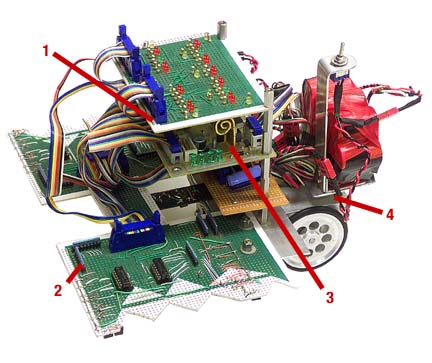
AARON OHTA AND THE UH
ENGINEERING DEPARTMENT'SHigh science
Aaron Ohta won this year's Alton B. Zerby Award, given to the top graduating student in the Electrical Engineering National Honor Society. He heads to UCLA on Sept. 3 with a $42,000 scholarship in the school's graduate program in electrical engineering. He also earned a $114,000 National Science Foundation Graduate Research Fellowship. The 22-year-old Oahu resident won these awards based on several projects he worked on with other students during his undergraduate studies at the University of Hawaii. Some of those projects are shown here:
Micromouse
A-Maze-ing machine that uses its senses
The UH project was centered on competing at the Institute for Electrical and Electronics Engineers' (IEEE) annual Micromouse competition.About 20 undergraduate electrical engineering students represented UH, which competed against such schools as UC-Berkeley, UC-Davis, the University of Nevada (Reno), Sacramento State University and Chico State University.
UH has done well in the past seven years, earning three first-place finishes, two second-places, and a fourth- and fifth-place finish.
Ohta worked with three other students on a micromouse called Jane. It finished fourth in 2002 and fifth last year.
The object of the competition is for the autonomous robot, or "mouse," to find its way into the center of a maze after starting in a corner.
The robot must have no prior knowledge of the maze's layout, and it must navigate and determine the fastest course to the center within a 10-minute time span.
Penalty time can be added. For example, 30 seconds can tacked on if a person picks up the robot after it crashes.
This can mean the difference between a first- or second- or even a third-place finish. A typical first-place time was about 30 seconds.
The robot must be less than 10 inches long, and all parts and materials must cost less than $500.
1. Central processing unit:
This is the brains of the mouse. The design uses a Motorola 68000 processor, the same one found in old Apple Mac computers. The programming is saved into a memory chip on the CPU board that allows programmers to tell the mouse how to navigate the maze.
2. Sensor board:
The eyes of the mouse. The walls of the maze reflect infrared light, so the Micromouse team used infrared sensors to "see" them. Sensors emit an infrared beam (just like a TV remote control) and detect any returning infrared light. If a wall was present, the infrared light bounced off and was detected. If no wall was there, the infrared light was not reflected. The layout of the sensors became critical in navigating the maze reliably (no crashes) and efficiently. Ohta and two others designed the sensor layout, and and Ohta fabricated the board.
3. Software:
Although the CPU does the "thinking," the software supplies the "thoughts" for the brain. The Micromouse team programmed everything the mouse does, from moving to turning. Ohta and two other students worked on the "tracking" code that kept the mouse moving straight down a maze path, controlling its turns and keeping it from crashing into walls.
4. Stepper motors:
These are the legs of the mouse. Stepper motors are the same kind of motors that make a computer floppy drive work.
Maze:
The maze that the Micromouse maneuvers through was about 9 12 feet long by 9 12 feet wide.
BACK TO TOP |
CubeSat project
INFORMATIONAL GRAPHIC BY DAVID SWANN / DSWANN@STARBULLETIN.COM
Click image for larger version.
Communicating via satellite
The UH CubeSat project is an undergraduate effort that involved more than 60 electrical, mechanical and civil engineering students, as well as nine faculty advisors.Students are in charge of designing, fabricating and testing the 2.2-pound, 1,000-cubic-centimeter satellite for launch into low-Earth orbit of about 400 miles sometime in the fall of 2004.
Although the UH Cubesat called Mea Huaka'i is small compared with conventional communications and research satellites (with masses of hundreds of kilograms), it still contained all the basic systems.
These included communications, power generation via solar cells and battery, and a flight processor that runs all satellite systems.
Mea Huaka'i's payload is an experimental high-frequency "active antenna."
By testing this antenna in orbit, the team hoped to lay the groundwork for the next generation of small satellite communications systems.
Ohta said he believes it will be the first time this technology will be tested in space.
As project director, he was responsible for the satellite's overall system design.
He also worked with the team that handled the communications system.
He organized and facilitated meetings and design reviews, coordinated fund raising and public
relations and managed the project's $120,000 budget.
BACK TO TOP |
Wireless transceiver
Homemade walkie-talkie
This eight-person undergraduate project called for designing and building a half-duplex wireless transceiver (basically, a high-frequency walkie-talkie). A 5-gigahertz (GHz) operating frequency was chosen.
INFORMATIONAL GRAPHIC BY DAVID SWANN / DSWANN@STARBULLETIN.COM
Click image for larger version.


